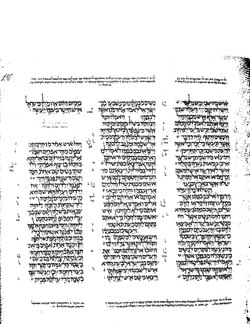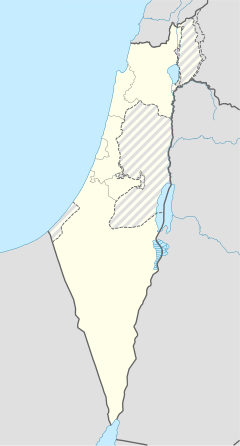1 Samuel 28
| 1 Samuel 28 | |
|---|---|
 The pages containing the Books of Samuel (1 & 2 Samuel) in Leningrad Codex (1008 CE). | |
| Book | First book of Samuel |
| Hebrew Bible part | Nevi'im |
| Order in the Hebrew part | 3 |
| Category | Former Prophets |
| Christian Bible part | Old Testament |
| Order in the Christian part | 9 |
1 Samuel 28 is the twenty-eighth chapter of the First Book of Samuel in the Old Testament of the Christian Bible or the first part of the Books of Samuel in the Hebrew Bible.[1] According to Jewish tradition the book was attributed to the prophet Samuel, with additions by the prophets Gad and Nathan,[2] but modern scholars view it as a composition of a number of independent texts of various ages from c. 630–540 BCE.[3][4] This chapter contains the account of David's escape from Saul's repeated attempts to kill him.[5][6] This is within a section comprising 1 Samuel 16 to 2 Samuel 5 which records the rise of David as the king of Israel.[7]
Text
[edit]This chapter was originally written in the Hebrew language. It is divided into 25 verses.
Textual witnesses
[edit]Some early manuscripts containing the text of this chapter in Hebrew are of the Masoretic Text tradition, which includes the Codex Cairensis (895), Aleppo Codex (10th century), and Codex Leningradensis (1008).[8] Fragments containing parts of this chapter in Hebrew were found among the Dead Sea Scrolls including 4Q51 (4QSama; 100–50 BCE) with extant verses 1–3, 22–25.[9][10][11][12]
Extant ancient manuscripts of a translation into Koine Greek known as the Septuagint (originally was made in the last few centuries BCE) include Codex Vaticanus (B; B; 4th century) and Codex Alexandrinus (A; A; 5th century).[13][a]
Places
[edit]The Philistines gather against Israel (28:1–2)
[edit]Verses 1–2 continue the story of David's time among the Philistines, which will be picked up again in chapters 29–30.[15] As the Philistines prepared for another war against Israel, David was placed in an awkward position to prove his loyalty to Achish by going to fight against his own people.[16]
Saul and the Medium of Endor (28:3–25)
[edit]
At his camp at Gilboa, facing the big army of Philistines at Shunem, Saul was in utter fear because he had no access to divine guidance, as described in verses 3–6:[15]
- Samuel was already dead and buried
- Saul had removed 'mediums and wizards' from the land, as was required by law (Leviticus 19:31; 20:6, 27; Deuteronomy 18:11).
- Saul did not get any answer when he sought YHWH's guidance through dreams, sacred lots (Urim) and prophets (cf. Jeremiah 18:18; Ezekiel 7:26).[15]
This caused Saul to desperately turn to prohibited means of getting to know the divine will, going against his own laws.[15] Because Endor was located northeast of Shunem, thus behind enemy lines, Saul had to go in disguise and at night.[15][17] The narrative about Saul's visit to the woman in Endor was 'one of the most bizarre texts in Scripture', as it claimed that Samuel's spirit could be called to speak through using witchcraft.[18] It is debatable whether it was really Samuel's spirit or the woman impersonating Samuel, because there was no new information was given other than what was already known from Samuel's speech long ago.[19] The text does say that the woman "saw a figure coming up", whom Saul assumed to be "Samuel" (verse 14), and was in terror (as perhaps she never had this result before), as well as got the knowledge that Saul was the one requesting this (verse 12).[20] The main point of the narrative is to show how Saul was totally cut off from YHWH, and failed as a king to protect Israel as he himself and his heirs would die at the hands of the Philistines.[15]
Verse 3
[edit]- Now Samuel had died, and all Israel had lamented for him and buried him in Ramah, in his own city. And Saul had put the mediums and the spiritists out of the land.[21]
The first sentence is a repetition of 1 Samuel 25:1.[22]
See also
[edit]- Related Bible parts: 1 Samuel 27, 1 Samuel 29, 1 Samuel 30
Notes
[edit]- ^ The whole book of 1 Samuel is missing from the extant Codex Sinaiticus.[14]
References
[edit]- ^ Halley 1965, p. 183.
- ^ Hirsch, Emil G. "SAMUEL, BOOKS OF". www.jewishencyclopedia.com.
- ^ Knight 1995, p. 62.
- ^ Jones 2007, p. 197.
- ^ Jones 2007, p. 209.
- ^ Coogan 2007, p. 433 Hebrew Bible.
- ^ Jones 2007, p. 207.
- ^ Würthwein 1995, pp. 35–37.
- ^ Ulrich 2010, pp. 287–288.
- ^ Dead sea scrolls - 1 Samuel
- ^ Fitzmyer 2008, p. 35.
- ^ 4Q51 at the Leon Levy Dead Sea Scrolls Digital Library
- ^ Würthwein 1995, pp. 73–74.
- ^
 This article incorporates text from a publication now in the public domain: Herbermann, Charles, ed. (1913). "Codex Sinaiticus". Catholic Encyclopedia. New York: Robert Appleton Company.
This article incorporates text from a publication now in the public domain: Herbermann, Charles, ed. (1913). "Codex Sinaiticus". Catholic Encyclopedia. New York: Robert Appleton Company.
- ^ a b c d e f Jones 2007, p. 213.
- ^ Evans 2018, p. 272.
- ^ Evans 2018, p. 280.
- ^ Evans 2018, p. 281.
- ^ Evans 2018, pp. 281–282.
- ^ Evans 2018, p. 282.
- ^ 1 Samuel 28:3 NKJV
- ^ Exell, Joseph S.; Spence-Jones, Henry Donald Maurice (Editors). On "1 Samuel 28". In: The Pulpit Commentary. 23 volumes. First publication: 1890. Accessed 24 April 2019.
Sources
[edit]Commentaries on Samuel
[edit]- Auld, Graeme (2003). "1 & 2 Samuel". In James D. G. Dunn and John William Rogerson (ed.). Eerdmans Commentary on the Bible. Eerdmans. ISBN 9780802837110.
- Bergen, David T. (1996). 1, 2 Samuel. B&H Publishing Group. ISBN 9780805401073.
- Chapman, Stephen B. (2016). 1 Samuel as Christian Scripture: A Theological Commentary. Wm. B. Eerdmans Publishing Company. ISBN 978-1467445160.
- Evans, Paul (2018). Longman, Tremper (ed.). 1-2 Samuel. The Story of God Bible Commentary. Zondervan Academic. ISBN 978-0310490944.
- Gordon, Robert (1986). I & II Samuel, A Commentary. Paternoster Press. ISBN 9780310230229.
- Hertzberg, Hans Wilhelm (1964). I & II Samuel, A Commentary (trans. from German 2nd edition 1960 ed.). Westminster John Knox Press. p. 19. ISBN 978-0664223182.
- Tsumura, David Toshio (2007). The First Book of Samuel. Eerdmans. ISBN 9780802823595.
General
[edit]- Breytenbach, Andries (2000). "Who Is Behind The Samuel Narrative?". In Johannes Cornelis de Moor and H.F. Van Rooy (ed.). Past, Present, Future: the Deuteronomistic History and the Prophets. Brill. ISBN 9789004118713.
- Coogan, Michael David (2007). Coogan, Michael David; Brettler, Marc Zvi; Newsom, Carol Ann; Perkins, Pheme (eds.). The New Oxford Annotated Bible with the Apocryphal/Deuterocanonical Books: New Revised Standard Version, Issue 48 (Augmented 3rd ed.). Oxford University Press. ISBN 978-0195288810.
- Fitzmyer, Joseph A. (2008). A Guide to the Dead Sea Scrolls and Related Literature. Grand Rapids, MI: William B. Eerdmans Publishing Company. ISBN 9780802862419.
- Halley, Henry H. (1965). Halley's Bible Handbook: an abbreviated Bible commentary (24th (revised) ed.). Zondervan Publishing House. ISBN 0-310-25720-4.
- Hayes, Christine (2015). Introduction to the Bible. Yale University Press. ISBN 978-0300188271.
- Jones, Gwilym H. (2007). "12. 1 and 2 Samuel". In Barton, John; Muddiman, John (eds.). The Oxford Bible Commentary (first (paperback) ed.). Oxford University Press. pp. 196–232. ISBN 978-0199277186. Retrieved February 6, 2019.
- Klein, R.W. (2003). "Samuel, books of". In Bromiley, Geoffrey W (ed.). The International Standard Bible Encyclopedia. Eerdmans. ISBN 9780802837844.
- Knight, Douglas A (1995). "Chapter 4 Deuteronomy and the Deuteronomists". In James Luther Mays, David L. Petersen and Kent Harold Richards (ed.). Old Testament Interpretation. T&T Clark. ISBN 9780567292896.
- Ulrich, Eugene, ed. (2010). The Biblical Qumran Scrolls: Transcriptions and Textual Variants. Brill.
- Würthwein, Ernst (1995). The Text of the Old Testament. Translated by Rhodes, Erroll F. Grand Rapids, MI: Wm. B. Eerdmans. ISBN 0-8028-0788-7. Retrieved January 26, 2019.
External links
[edit]- Jewish translations:
- Shmuel I - I Samuel - Chapter 28 (Judaica Press). Hebrew text and English translation [with Rashi's commentary] at Chabad.org
- Christian translations:
- Online Bible at GospelHall.org (ESV, KJV, Darby, American Standard Version, Bible in Basic English)
- 1 Samuel chapter 28. Bible Gateway
